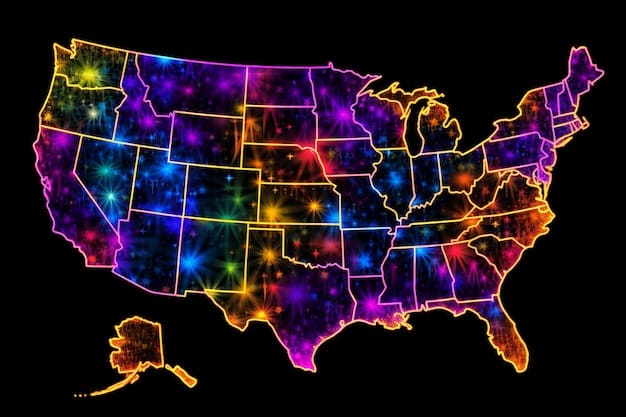Unlocking US Streaming: Guide to Regional Content Restrictions 2025

Navigating US streaming in 2025 demands understanding regional content limitations, which are often dictated by licensing agreements and geo-blocking technologies, impacting what viewers can access based on their physical location.
The landscape of
Understanding Geo-blocking and Content Licensing
Geo-blocking is a significant barrier for many streamers, preventing access to content based on geographical location. This practice is not arbitrary; it’s deeply rooted in the intricate world of content licensing and distribution agreements. These agreements dictate where, when, and for how long a particular piece of content can be streamed. For instance, a film studio might sell the streaming rights for a movie to one platform in the East Coast and a different platform in the West Coast, or even exclusively to a single platform for a limited time in specific states. These complexities arise from the commercial strategies of content creators and distributors, seeking to maximize revenue by segmenting markets.
The core of these restrictions lies in copyright law and intellectual property. Content owners, be they film studios, sports leagues, or music labels, have the right to control how their intellectual property is distributed. They often negotiate exclusive deals for specific territories to safeguard their investments and optimize profit margins. As a result, your IP address becomes a digital key, determining which content libraries are unlocked for you. This means that even within the seemingly unified market of the United States, a show available in California might be unavailable in New York, leading to a fragmented viewing experience. The implications extend beyond simple unavailability, influencing subscription choices and the overall perceived value of streaming services.
The Legal Framework Behind Regional Content
The legal underpinning for regional content restrictions is robust, stemming from a combination of national and international copyright laws. These laws grant content creators and distributors the exclusive right to control the distribution and public performance of their works. Companies then negotiate these rights on a territorial basis, creating a patchwork of availability. It’s a system designed to protect investments and allow for tailored market strategies, but it inadvertently creates a complex web for consumers.
- Territorial Licensing: Content rights are often sold for specific geographical regions, meaning a show available on Netflix in the UK might not be available on Netflix in the US, or even on a different platform within the US.
- Distribution Deals: Major studios sign lucrative deals with streaming services, often granting exclusive rights for certain content within predefined territories, lasting for specified periods.
- Copyright Enforcement: Geo-blocking serves as a technical enforcement mechanism for these legal agreements, ensuring that content is only accessed where its distribution rights have been legitimately acquired.
These legal agreements are not static; they frequently expire, are renegotiated, or are challenged, leading to content periodically appearing or disappearing from streaming libraries. This dynamic environment requires constant vigilance from both services and consumers. Understanding that these restrictions are primarily business-driven—rather than technical limitations—can help viewers appreciate the broader context of their regional streaming challenges. The constant fluidity of these contracts is what makes the streaming landscape so unpredictable, necessitating frequent updates to any comprehensive guide.
The Impact of State-Specific Licensing in 2025
While often overlooked, state-specific licensing agreements play a significant role in content availability within the US. In 2025, this trend is likely to intensify, particularly for live sports, local news, and regional programming. Major sports leagues, for instance, frequently have blackout rules that prevent games from being streamed in local markets, even if you subscribe to a national package. This is usually to protect the interests of local broadcasters and generate ticket sales for regional teams. These localized restrictions can be incredibly frustrating for fans who travel or live in border regions.
Beyond live sports, smaller content producers or regional cable networks might license their shows exclusively to platforms available only in certain states. This creates a fascinating but complex ecosystem where a show championed by a local community may never reach a national audience through major streaming services. It highlights the granular level at which content distribution operates, far beyond mere country-level restrictions. Consumers need to be aware that even within the same country, their physical location can be the determining factor in their viewing options. This intricate web of agreements demands a more nuanced approach from streamers than simply assuming national availability.
Challenges Posed by Local Blackouts
Local blackouts, particularly for sports, are a perpetual source of frustration for American fans. These restrictions are designed to funnel viewers towards local cable broadcasts or direct attendance at games, protecting local revenue streams. For example, a subscriber in Dallas might be blacked out from watching a Dallas Mavericks game on their national streaming package because a local TV station has exclusive broadcast rights. This often means missing out on crucial matches simply due to geographic proximity.
- Sports Leagues: NFL, NBA, MLB, and NHL all have specific blackout rules tied to local markets, affecting both live and on-demand content.
- Regional Sports Networks (RSNs): Many exclusive distribution deals are struck with RSNs, meaning their content is only accessible within the network’s designated broadcast area.
- Impact on Cord-Cutters: These blackouts disproportionately affect cord-cutters who rely solely on streaming, forcing some to consider traditional cable subscriptions for specific events.
The nature of these blackouts means that even employing VPNs can be problematic, as services become increasingly sophisticated at detecting and blocking VPN usage. This forces users into a cat-and-mouse game with streaming providers and content distributors. The continuous battle between viewers wanting universal access and rights holders protecting their localized revenue streams remains a defining characteristic of the 2025 streaming landscape. Consumers are increasingly searching for official solutions to bypass these obstacles, rather than relying on unofficial workarounds.
Technological Enforcement: How Geo-restrictions Work
The enforcement of regional content restrictions relies heavily on sophisticated technological mechanisms, primarily examining your IP address. When you connect to the internet, your device is assigned a unique IP address that contains information about your geographical location. Streaming services use databases to cross-reference this IP address against licensed content territories. If your IP address falls outside the authorized region for a particular show or movie, access is denied. This process is seamless and often invisible to the user until a message like “This content is not available in your region” appears on screen.
Beyond simple IP address checks, streaming providers employ more advanced methods to detect and prevent circumvention attempts, particularly from VPNs (Virtual Private Networks). These methods include DNS (Domain Name System) blocking, GPS spoofing detection on mobile devices, and even analyzing traffic patterns for anomalies that suggest VPN usage. The arms race between providers implementing tighter geo-blocks and users finding ways around them continues to escalate. Understanding these technical underpinnings is crucial for anyone attempting to navigate the restrictions, as it explains why certain workarounds may cease to function over time. The sophistication of these systems means that casual attempts to bypass them are often unsuccessful, demanding more robust and reliable solutions.
The Role of VPNs and Smart DNS Tools
For many years, VPNs (Virtual Private Networks) have been the go-to solution for bypassing geo-restrictions. By routing your internet traffic through a server in a different location, a VPN can effectively mask your true IP address, making it appear as though you are browsing from another region. This can potentially unlock content unavailable in your actual location. Similarly, Smart DNS services operate by redirecting specific parts of your internet traffic related to geo-location, without encrypting your entire connection. This often results in faster speeds, making them appealing for streaming.

- VPN Features: Encrypts internet traffic, hides IP address, and offers server locations in various countries/states. Good for privacy and security alongside geo-unblocking.
- Smart DNS Advantages: Typically faster than VPNs as they don’t encrypt data, easier to set up on a wider range of devices (e.g., smart TVs, gaming consoles) that don’t natively support VPN apps.
- Detection and Blocking: Streaming services actively detect and block IP addresses associated with known VPN/Smart DNS providers, leading to a constant cat-and-mouse game for access.
In 2025, the effectiveness of VPNs and Smart DNS tools against major streaming platforms is a mixed bag. While many basic VPNs are easily detected, premium providers invest heavily in maintaining unblocked servers and sophisticated detection evasion methods. However, no solution is foolproof, and constant updates are required from both sides. The key is to choose a reputable provider known for its ability to bypass streaming geo-blocks, and to understand that their effectiveness can fluctuate. The decision between a VPN and Smart DNS often comes down to individual priorities: security versus speed and device compatibility. Furthermore, it’s important for users to be aware of the terms of service of their chosen streaming platform, as using these tools to circumvent geo-restrictions can sometimes be against their user agreements.
Major Streaming Platforms: Navigating US Regional Content
Each major streaming platform has its own approach to regional content distribution within the United States. What you can watch on Netflix in one state might differ slightly from another due to localized licensing. Likewise, Hulu, Max, and Disney+ all tailor their content libraries based on a complex matrix of agreements. For instance, Hulu excels in providing localized live TV and regional sports content, often adhering to blackout rules more strictly than others. This is largely because their core offering includes live channels tied to local broadcast markets. Max, leveraging the extensive Warner Bros. and HBO catalog, also faces regional nuances, particularly with sports and movie premiere windows. Disney+, while largely uniform, can experience localized release schedules for specific titles.
Navigating these platforms requires an understanding of their individual strategies. Some services might emphasize national uniformity, while others prioritize local market integration. The variation is subtle but important, particularly for niche content or regional sports. It’s not uncommon for a user to find a desired show listed on a service, only to discover it’s unavailable in their specific state. This fragmented experience highlights the ongoing challenge of content consolidation and universal access. Keeping an eye on platform-specific announcements regarding regional availability changes can help avoid disappointment and unexpected limitations in 2025. This constant state of flux necessitates a proactive approach from consumers seeking specific content.
Netflix’s Shifting Libraries
Netflix, while known for its global presence, maintains distinct content libraries for different countries, and to a lesser extent, sometimes within specific regions of the US. While the majority of its US catalog is consistent nationwide, localized licensing agreements, particularly for older content or specific regional sports documentaries, can introduce subtle variations. Their sophisticated geo-blocking detection systems are among the most robust, making it challenging for even premium VPNs to consistently bypass their regional restrictions. The platform’s commitment to respecting licensing agreements means they actively work to prevent access from unauthorized locations.
The primary concern for Netflix users in 2025 regarding regional content within the US typically revolves around how content licensed from other studios interacts with their specific locale. For example, a movie that has theatrical or pay-per-view exclusivity in certain states might delay its Netflix release in those specific areas. While Netflix strives for a uniform US library, these minor deviations do occur. Staying informed about content acquisition announcements and local licensing news is the best way to anticipate these shifts. The focus for Netflix continues to be on its original content, which tends to have more universal availability within its licensed territories, but third-party titles remain subject to the whims of regional contracts.
Hulu’s Live TV and Local Impact
Hulu, with its strong emphasis on live television and next-day content from major networks, is particularly susceptible to regional content restrictions within the US. Its Hulu + Live TV service ties directly into local broadcast affiliates, which means your access to specific channels, sports, and local news is entirely dependent on your geographical location. If a local NBC affiliate in your area has exclusive rights to certain programming, Hulu will only serve you that content if your IP address matches that service area. This is a crucial distinction from on-demand services, as it mirrors the traditional cable television model where local channels are dictated by your physical address.

The implications of this for 2025 are significant, especially for sports fans or those who follow local news. Traveling out of your home market can mean losing access to your local channels, even with a Hulu + Live TV subscription. While Hulu does offer some national sports coverage, local blackouts are rigorously enforced to protect regional broadcast rights. This makes Hulu + Live TV a highly geo-sensitive service, where understanding your local market’s offerings is paramount. Users often find themselves checking their ZIP code on Hulu’s website to ascertain which local channels are available before subscribing. This localized approach is both a strength, in providing relevant local content, and a limitation, by tethering subscribers to specific geographical viewing options.
Future Trends and Consumer Strategies for 2025
Looking ahead to 2025, several trends are likely to shape the landscape of regional content restrictions in US streaming. We can anticipate continued consolidation within the streaming industry, which might lead to more uniform content libraries on the acquiring platforms, but also the potential for major content holders to pull their shows from competitors for exclusive distribution. The increasing sophistication of geo-blocking technologies will also present new challenges for current circumvention methods, pushing providers to innovate further. Furthermore, regulatory bodies might begin to address the complexities of cross-border content access, potentially advocating for more unified streaming experiences, though this remains speculative.
From a consumer perspective, adapting effective strategies will be vital. Subscription stacking, where users subscribe to multiple services to cover their content needs, will likely remain prevalent. However, smart management of these subscriptions, canceling and reactivating based on content availability, could become a more nuanced strategy. Consumers will need to be savvier about checking content availability maps and staying informed about changing licensing agreements. The future of US streaming will likely be a balance between expanding content offerings and maintaining territorial integrity, requiring both services and users to adapt constantly. This dynamic environment places the onus on consumers to be informed and strategic in their viewing choices.
Emerging Technologies and DRM
The ongoing evolution of Digital Rights Management (DRM) technologies is a critical factor influencing regional content restrictions. In 2025, we can expect DRM systems to become even more sophisticated, making it increasingly difficult to bypass geo-blocks. These advanced systems don’t just rely on IP addresses; they might incorporate machine learning to detect unusual access patterns, device fingerprinting, and even behavioral analytics to identify users attempting to circumvent restrictions. The goal is to create a seamless and secure content delivery ecosystem that strictly adheres to licensing terms.
- AI and Machine Learning: Algorithms analyze user behavior and connection metadata to flag suspicious activities indicative of geo-block circumvention.
- Enhanced Device Fingerprinting: Services can identify unique device characteristics, making it harder for users to switch virtual locations undetected.
- Blockchain for Content Rights: While still nascent, blockchain technology could revolutionize content licensing by providing immutable, transparent records of rights, potentially making enforcement more precise but also more rigid.
These emerging technologies pose a significant challenge for consumers hoping to bypass regional restrictions. The cat-and-mouse game will likely become more complex, requiring more robust and potentially more expensive circumvention tools. The emphasis for streaming services will be on prevention rather than detection, creating a more locked-down environment. This technological arms race underscores the seriousness with which content owners and distributors approach the protection of their territorial rights. As technology becomes more advanced, the ease of bypassing these restrictions for the average user will likely diminish, pushing them towards officially licensed content accessible within their region.
Best Practices for US Streamers in 2025
For US streamers navigating the dynamic content landscape of 2025, adopting a few best practices can significantly enhance their viewing experience. Firstly, always verify content availability before committing to a subscription, especially for specific shows, movies, or sports events. Many streaming services offer search tools or lists of available content by region. Secondly, consider a “seasonal” approach to subscriptions, subscribing only to services that offer the content you want during specific periods, then canceling until new content or events become available. This can save money and reduce frustration.
Furthermore, staying informed about industry news, particularly regarding major licensing deals and changes in content catalogs, is crucial. Following reputable tech news sites or streaming review platforms can provide valuable insights into what’s coming and going. For those considering VPNs or Smart DNS, research premium providers known for their consistent performance with streaming services, and be prepared for potential fluctuations in effectiveness. Lastly, embrace the “search and discover” mentality. Sometimes, the content you want might be available on a lesser-known platform or through a different type of digital purchase. The key to unlocking US streaming in 2025 lies in proactive research, flexible subscription habits, and an understanding of the underlying forces shaping content distribution. By adopting these strategies, streamers can proactively manage their expectations and reduce the frustration associated with regional content restrictions.
Tips for Maximizing Your Streaming Experience
To truly maximize your streaming experience in 2025 while contending with regional restrictions, a multifaceted approach is required. Beyond simply subscribing to services, optimizing your setup and habits can make a significant difference. Consider investing in a reliable internet connection, as buffering due to slow speeds can be as frustrating as geo-blocks. Utilize playback quality settings wisely, especially on mobile devices, to conserve data and prevent interruptions. Organize your streaming apps and services to easily find content you’re interested in, perhaps even using a universal search tool if your smart TV or streaming device offers one.
- Content Calendars: Keep track of release dates for new shows and movies on your preferred platforms to effectively manage your subscriptions.
- Trial Periods: Make use of free trial periods for new services to test content libraries and check for regional availability before committing financially.
- Community Forums: Join online communities or forums dedicated to streaming to learn about content availability, VPN performance, and user tips relevant to your region.
- Device Compatibility: Ensure your streaming devices (smart TVs, streaming sticks, gaming consoles) are compatible with the services you use and any potential circumvention tools.
By taking a comprehensive approach to your streaming habits and understanding the nuances of regional content, you can transform what might otherwise be a frustrating experience into a streamlined and enjoyable one. The goal is to move beyond simply accessing content to truly optimizing your entire digital entertainment ecosystem. This involves not just knowing where to find content, but also how to best consume it given the technological and logistical constraints. Empowering yourself with knowledge and practical tools is the ultimate strategy for success in the evolving world of US streaming. This proactive stance ensures that you are always in control of your entertainment choices, rather than being dictated by the limitations of regional licensing.
| Key Point | Brief Description |
|---|---|
| 🗺️ Geo-blocking Basics | Content access is restricted by location due to licensing agreements and IP address tracking. |
| 📍 State-Specific Licensing | Live sports and regional programming often have distinct availability based on individual state agreements. |
| 🔐 Tech Enforcement & VPNs | Sophisticated DRM and IP detection systems challenge VPNs; premium services offer more consistent bypass. |
| 💡 Future Strategies | Stay informed, manage subscriptions actively, and research reliable tools to enhance your streaming experience in 2025. |
Frequently Asked Questions About US Streaming Restrictions
▼
Streaming services are restricted by region primarily due to content licensing agreements. Content owners, like film studios or sports leagues, sell distribution rights for specific geographical territories to maximize their revenue and protect their investments. These agreements dictate where and when content can be streamed, leading to variations in libraries across different states or even within sub-regions of the US.
▼
Using a VPN can potentially bypass US regional streaming restrictions by masking your true IP address. However, streaming services are increasingly sophisticated in detecting and blocking known VPN servers. While some premium VPN services invest heavily in maintaining unblocked servers, there’s no guarantee of consistent access. Users should also be aware that using VPNs to circumvent geo-blocks might violate a streaming service’s terms of service.
▼
State-specific content licenses significantly impact live sports streaming through “blackout rules.” These rules prevent games from being streamed in local markets where a regional broadcaster or cable channel holds exclusive rights. This is done to protect local viewership and ticket sales. Even with national sports packages, you might find certain games unavailable if you are within the local market of a participating team.
▼
VPNs (Virtual Private Networks) encrypt all your internet traffic and route it through a server in a different location, fully hiding your IP address. Smart DNS services, on the other hand, only redirect DNS queries related to geo-location, without encrypting your entire connection. Smart DNS is often faster and works on more devices, but offers no security benefits and can be more easily detected by streaming services.
▼
While the fundamental mechanism of regional content restrictions (licensing) is unlikely to change entirely by 2025, we can expect increasing sophistication in geo-blocking technologies and continuous shifts in content availability. Industry consolidation might lead to some content becoming exclusive to fewer platforms. Regulatory discussions around cross-border access could also influence future policies, though this is a long-term prospect.
Conclusion
Navigating the complex world of US streaming in 2025, with its myriad regional content restrictions, demands both understanding and strategic adaptation. From the granular details of state-specific licensing for live sports to the technological arms race between geo-blocking and circumvention tools, the landscape remains dynamic and often challenging. By understanding the commercial drivers behind these restrictions, remaining informed about content shifts, and employing smart viewing strategies, consumers can unlock a more satisfying and comprehensive entertainment experience. The future of streaming is one where informed viewers are best equipped to leverage the vast content libraries available, transforming potential frustration into seamless access.





